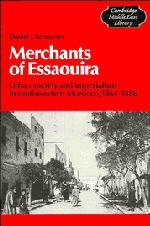Book contents
- Frontmatter
- Contents
- List of illustrations
- Map 1 General map of Morocco
- Preface
- Notes on usage
- Abbreviations
- Chronology
- 1 Introduction
- 2 The royal port
- 3 Merchants of the Sultan
- 4 Port and bazaar
- 5 Beyond the walls
- 6 The politics of trade
- 7 Foreign intervention and domestic reforms
- 8 The struggle for the southwest
- 9 The people of Essaouira in precolonial times
- 10 The end of an era
- Appendix A Corcos collection: nineteenth-century Arabic documents (1843–83)
- Appendix B Population estimates of Essaouira
- Appendix C Balancing revenue and expenditure: accounts of the port
- Appendix D Trade statistics for Essaouira
- Notes
- Bibliography
- Index
4 - Port and bazaar
Published online by Cambridge University Press: 04 August 2010
- Frontmatter
- Contents
- List of illustrations
- Map 1 General map of Morocco
- Preface
- Notes on usage
- Abbreviations
- Chronology
- 1 Introduction
- 2 The royal port
- 3 Merchants of the Sultan
- 4 Port and bazaar
- 5 Beyond the walls
- 6 The politics of trade
- 7 Foreign intervention and domestic reforms
- 8 The struggle for the southwest
- 9 The people of Essaouira in precolonial times
- 10 The end of an era
- Appendix A Corcos collection: nineteenth-century Arabic documents (1843–83)
- Appendix B Population estimates of Essaouira
- Appendix C Balancing revenue and expenditure: accounts of the port
- Appendix D Trade statistics for Essaouira
- Notes
- Bibliography
- Index
Summary
From harbour to bazaar
A foreign trader coming to Essaouira caught his first glimpse of the town as his ship sailed between the island and the port where the harbour was located. The ship would then anchor and wait for the lighters operated by either the Banī ʿAntar or Ahl Agādīr boatmen. In winter months anchorage would sometimes be hazardous for those in sailing ships, particularly if caught in western winds. Otherwise, the bay would be fairly calm and the visitor would promptly set foot at the landing and proceed through the port gate, Bāb al-Marsa. To the right of the gate were storehouses belonging to customs where merchandise was stored, sometimes in lieu of paying duties in specie. Merchants would also store goods there which had cleared customs prior to shipment. Continuing towards the town, the traveller would probably pass numerous sacks of goods, camels, brokers, and porters unloading merchandise or assembling caravans for the long journeys to the Sous. Together with the merchandise and a porter, he would then move into the mashwar, the area adjacent to the makhzan palace used for horses and gunpowder, games and other festivites, and enter Bāb Muhammad Ū Masʿūd, proceed to the large square at the centre of the casbah, and finally enter the customs house (dār al-aʿshār) where a 10 per cent ad valorem duty would be assessed by the customs officials for any goods imported.
- Type
- Chapter
- Information
- Merchants of EssaouiraUrban Society and Imperialism in Southwestern Morocco, 1844–1886, pp. 61 - 84Publisher: Cambridge University PressPrint publication year: 1988



